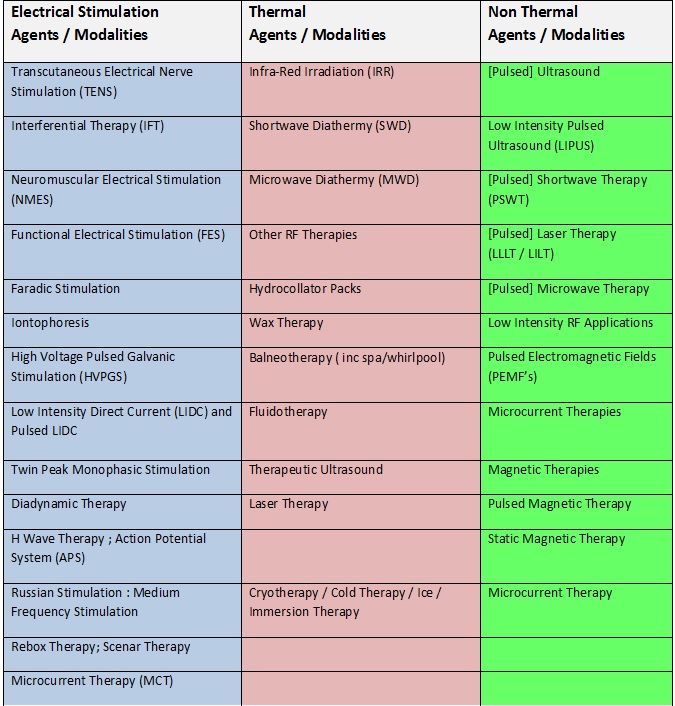Traditional Physiotherapy Interventions for Pain Conditions: Difference between revisions
mNo edit summary |
No edit summary |
||
| Line 52: | Line 52: | ||
=== Mobilization === | === Mobilization === | ||
Manual therapy can be broadly defined as | |||
"...the use of hands in a curative and healing manner or a hands-on technique with therapeutic intent..."<ref name="Led">Lederman E. The Science and Practice of Manual therapy. 2nd ed. Elsevier: London. (2005)</ref> | |||
A detailed explaination of Mobilisation and its effect on pain can be read on this Physiopedia page: '''[http://www.physio-pedia.com/Maitland's_Mobilisations Maitlands Mobilisations]''' | |||
=== Manipulation === | === Manipulation === | ||
Revision as of 13:09, 21 April 2016
- Please do not edit unless you are involved in this project, but please come back in the near future to check out new information!!
- If you would like to get involved in this project and earn accreditation for your contributions, please get in touch!
Tips for writing this page:
- What is the current evidence base for the use of the following traditional therapy modalities with patients in pain? :electrotherapy/acupuncture/manipulation/massage/relaxation
- What are the proported theraputic effects?
- Should they, and how can they, be integrated with pharmacological, sociological and psychological interventions and approaches to managing pain experiences and re-integartion with function?
Original Editor - Kudzanayi Ronald Muzenda and Jo Etherton
Top Contributors - Kudzanayi Ronald Muzenda, Joanne Garvey, Kim Jackson, Evan Thomas, Jo Etherton, WikiSysop, Simisola Ajeyalemi, Lauren Lopez, Jess Bell, Yigit Unalan, Rachael Lowe and Lucinda hampton
Traditional Physiotherapy Modalities[edit | edit source]
Electrotherapy[edit | edit source]
The term electrotherapy and electrophyical agents have been used interchangeably to describe the modalities used in physiotherapy. Some suggest that the term electrotherapy implies modalities that use electric current only in treatment.
The following table categorizes various modalities into three groups, i.e. electrical stimulation agents, thermal agents, and non-thermal agents[1]
Electrical stimulation agents and thermal agents are the most used in physiotherapy pain management. However, non-thermal agents, such as pulsed ultrasound, have been reported as having an analgesic effect.
Eectrical Stimulation[edit | edit source]
The exact mechanism of electrical stimulation’s beneficial effect remains controversial. Electrical stimulation is said directly block pain signals from reaching the brain so that the patient never experiences them. In addition, electrical stimulation has been shown to promote the release of endorphins which are natural painkillers produced by the body.Pain reduction occurs because the applied electrical fields act to close the body's "pain gate mechanism"TENS ( Transcutaneous Electrical Nerve Stimulation) is the widely used electical modality for chronic pain.
Current Evidence[edit | edit source]
Thermal Agents[edit | edit source]
When applied in successive fashion, heat and cold are believed to exert a physiological effect on your body's pain gate mechanism, which temporarily alters pain signals traveling to and from your brain. This temporary reduction in pain is a welcome relief for those suffering long-standing complaints of the nervous and musculoskeletal systems.
Non-thermal agents are believed to work by...
Cur
Non-Thermal Agents[edit | edit source]
[edit | edit source]
.
[edit | edit source]
Manual Therapy[edit | edit source]
Mobilization[edit | edit source]
Manual therapy can be broadly defined as
"...the use of hands in a curative and healing manner or a hands-on technique with therapeutic intent..."[2]
A detailed explaination of Mobilisation and its effect on pain can be read on this Physiopedia page: Maitlands Mobilisations
Manipulation[edit | edit source]
Soft Tissue[edit | edit source]
Purported Therapeutic Effects[edit | edit source]
Current Evidence[edit | edit source]
Acupuncture/Dry Needling[edit | edit source]
Purported Therapeutic Effects[edit | edit source]
Current Evidence[edit | edit source]
Additional Resources[edit | edit source]
References[edit | edit source]
- ↑ Key concepts in electrotherapy.http://www.electrotherapy.org/modality/key-concepts-in-electrotherapy.(Accessed 19 March 2016)
- ↑ Lederman E. The Science and Practice of Manual therapy. 2nd ed. Elsevier: London. (2005)







